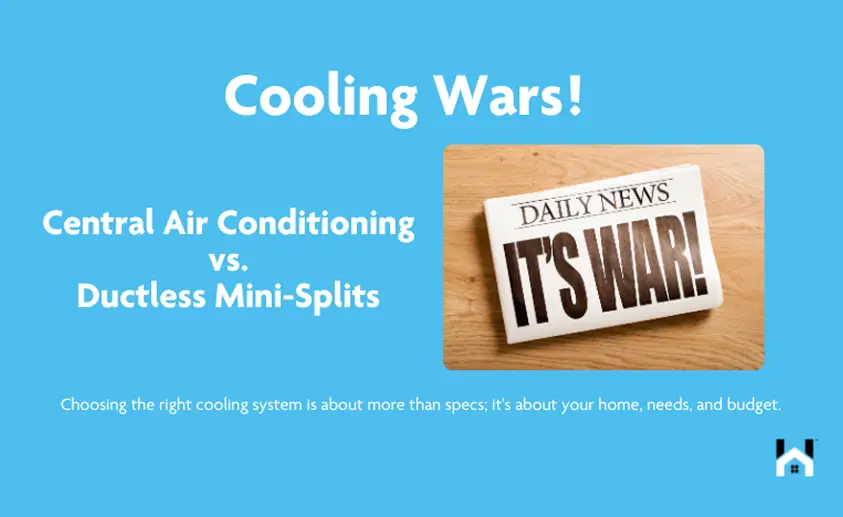Cooling Wars: Central Air Conditioning vs Ductless Mini-Splits

It's time to upgrade your home's cooling system, but the choices are overwhelming! Two major contenders stand out: traditional central air conditioning and the increasingly popular ductless mini-splits. Which one reigns supreme? Let's break down the pros and cons to help you decide.
Central Air Conditioning: The Tried and True Classic
- How it Works: A central AC system uses an outdoor unit (condenser) and an indoor unit (evaporator coil) connected by refrigerant lines. Cooled air travels through a network of ducts to vents throughout your home.
- Pros:
- Whole-home coverage: Ideal for cooling an entire house evenly.
- Powerful cooling: Can handle larger homes and hotter climates effectively.
- Less Noticeable: Indoor units are often tucked away in the attic or basement.
- Cons:
- Ductwork Required: Not suitable for homes without pre-existing ducts.
- Higher Installation Costs: Installing ductwork adds to the expense.
- Potential Energy Loss: Leaky ducts can waste cooled air, reducing efficiency.
Ductless Mini-Splits: The Flexible Newcomer
- How it Works: Mini-splits also have indoor and outdoor units. However, each indoor unit is mounted on a wall, in the ceiling, or recessed and provides cooling for a room or specific zone. No ducts needed!
- Pros:
- Zoned Cooling: Control temperatures room by room – perfect for different preferences or unused spaces.
- Super Efficiency: Ductless systems tend to be highly energy-efficient.
- Easy Installation: No ducts make installation less invasive, especially for older homes.
- Heating Options: Many mini-splits offer both heating and cooling for year-round use.
- Cons:
- Limited Range: A single indoor unit may not perfectly cool a very large or complex space.
- Less Discreet: Indoor units are visible, impacting aesthetics for some homeowners.
- Generally More Expensive: While efficient, mini-splits can have a higher upfront cost than central units.
Busting Myths: Common Misconceptions About Ductless Mini-Splits
While ductless mini-splits are becoming increasingly popular, there's still some misinformation out there. Let's set the record straight:
- Myth 1: Mini-Splits Are Only for Tiny Spaces
False: While mini-splits excel at cooling individual rooms or additions, modern systems can effectively cool multiple zones. One outdoor unit can connect to several indoor units, providing cooling for larger and more complex areas.
- Myth 2: Mini-Splits Are Always More Expensive
True: The upfront cost of a ductless system might be higher compared to a simple central AC unit. However, mini-splits are super energy-efficient, often leading to significant savings on your utility bills over time. Factor in the cost of installing ducts in a house without them, and mini-splits become a much more competitive option.
- Myth 3: Mini-Split Installation Is a DIY Project
False: While some aspects of mini-split installation might seem straightforward, the process involves handling refrigerant, which requires specialized knowledge and licensing. A certified HVAC technician ensures correct installation, prevents leaks of harmful refrigerant, and maximizes your system's efficiency.
- Myth 4: All Mini-Splits Look the Same
False: Those old, bulky wall-mounted units are a thing of the past! Mini-splits now come in sleek designs, various colors, and even recessed ceiling-mounted options. They can blend seamlessly into your home's decor.
The Verdict: It Depends!
Which one is best for YOU depends on your specific needs and priorities:
- Need Whole-House Cooling, Especially in a Hot Climate? Central AC might be the way to go.
- Don't Have Ducts or Want Targeted Cooling? Mini-splits are likely your best bet.
- Prioritize Energy Efficiency? Ductless usually wins this category.
- On a Tight Budget? Central AC might be cheaper if you have existing ducts.
Additional Considerations
- Air Quality: Central air units can typically be fitted with a whole-house filtration system, while ductless units have smaller filters in each indoor unit. For allergy sufferers, this might be a key factor.
- Noise Levels: Both systems have improved, but ductless mini-split indoor units tend to be whisper-quiet compared to the airflow sounds of a central AC.
The Verdict: It Depends...Even More!
Let's make things even clearer with specific scenarios where one system might excel over the other:
- Adding A/C to an Older Home without Ducts: Mini-split is the clear winner due to its less invasive installation.
- Cooling a Large, Open-Concept Home: Central AC likely has the power to handle this uniform cooling better.
- Home with Unused Rooms or Additions: Mini-splits let you save money by only cooling the areas you use.
- Family with Different Temperature Preferences: Zoned control of a mini-split lets everyone be happy.
Still Unsure? HOWIE Knows How to Help
Choosing the right cooling system is about more than specs; it's about your home, needs, and budget. HOWIE can connect you with local HVAC experts. They'll evaluate your home, discuss your lifestyle, and offer unbiased recommendations for the system best suited for your comfort.

Need help with
your project?
Whether you’re planning a project or just trying to remember when to clean your gutters, we’ve got your back (and your inbox).



